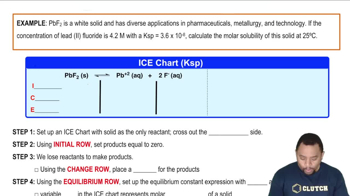Write balanced equations and expressions for Ksp for the dissolution of each ionic compound. a. CaCO3 b. PbCl2 c. AgI
Ch.17 - Aqueous Ionic Equilibrium
Chapter 17, Problem 88
Refer to the Ksp values in Table 17.2 to calculate the molar solubility of each compound in pure water. a. MX (Ksp = 1.27⨉10-36) b. Ag2CrO4 c. Ca(OH)2
 Verified step by step guidance
Verified step by step guidance1
Identify the dissolution equation for each compound. For example, for MX, the dissolution is MX(s) \rightleftharpoons M^+(aq) + X^-(aq).
Write the expression for the solubility product constant (K_{sp}) for each compound. For MX, K_{sp} = [M^+][X^-].
Express the concentrations of the ions in terms of the molar solubility (s). For MX, [M^+] = s and [X^-] = s, so K_{sp} = s^2.
Solve for the molar solubility (s) by substituting the given K_{sp} value into the expression and solving for s. For MX, s = \sqrt{K_{sp}}.
Repeat the process for Ag_2CrO_4 and Ca(OH)_2, considering their respective dissolution equations and stoichiometry. For Ag_2CrO_4, K_{sp} = [Ag^+]^2[CrO_4^{2-}], and for Ca(OH)_2, K_{sp} = [Ca^{2+}][OH^-]^2.

Verified video answer for a similar problem:
This video solution was recommended by our tutors as helpful for the problem above.
Video duration:
2mWas this helpful?
Key Concepts
Here are the essential concepts you must grasp in order to answer the question correctly.
Solubility Product Constant (Ksp)
The solubility product constant (Ksp) is an equilibrium constant that applies to the solubility of sparingly soluble ionic compounds. It represents the maximum concentration of ions in a saturated solution at a given temperature. For a salt MX that dissociates into M⁺ and X⁻, Ksp is expressed as Ksp = [M⁺][X⁻]. Understanding Ksp is crucial for calculating the molar solubility of compounds in water.
Recommended video:
Guided course

Solubility Product Constant
Molar Solubility
Molar solubility is defined as the number of moles of a solute that can dissolve in one liter of solution at equilibrium. It is directly related to the Ksp value of the compound; a higher Ksp indicates greater molar solubility. To find the molar solubility, one must set up an expression based on the dissociation of the compound and solve for the concentration of the ions in solution.
Recommended video:
Guided course

Molar Solubility Example
Dissociation of Ionic Compounds
Ionic compounds dissociate into their constituent ions when they dissolve in water. For example, when Ca(OH)₂ dissolves, it separates into Ca²⁺ and 2OH⁻ ions. The stoichiometry of this dissociation is essential for calculating molar solubility, as it determines the relationship between the concentrations of the ions and the Ksp value. Understanding this process is key to solving solubility problems.
Recommended video:
Guided course

Ionic Compounds Naming
Related Practice
Textbook Question
Textbook Question
Refer to the Ksp values in Table 17.2 to calculate the molar solubility of each compound in pure water. a. AgBr
Textbook Question
Refer to the Ksp values in Table 17.2 to calculate the molar solubility of each compound in pure water. b. Mg(OH)2 c. CaF2
Textbook Question
Use the given molar solubilities in pure water to calculate Ksp for each compound. a. MX; molar solubility = 3.27⨉10-11 M
Textbook Question
Use the given molar solubilities in pure water to calculate Ksp for each compound. b. PbF2; molar solubility = 5.63⨉10-3 M c. MgF2; molar solubility = 2.65⨉10-4 M
Textbook Question
Use the given molar solubilities in pure water to calculate Ksp for each compound. a. BaCrO4; molar solubility = 1.08⨉10-5 M
